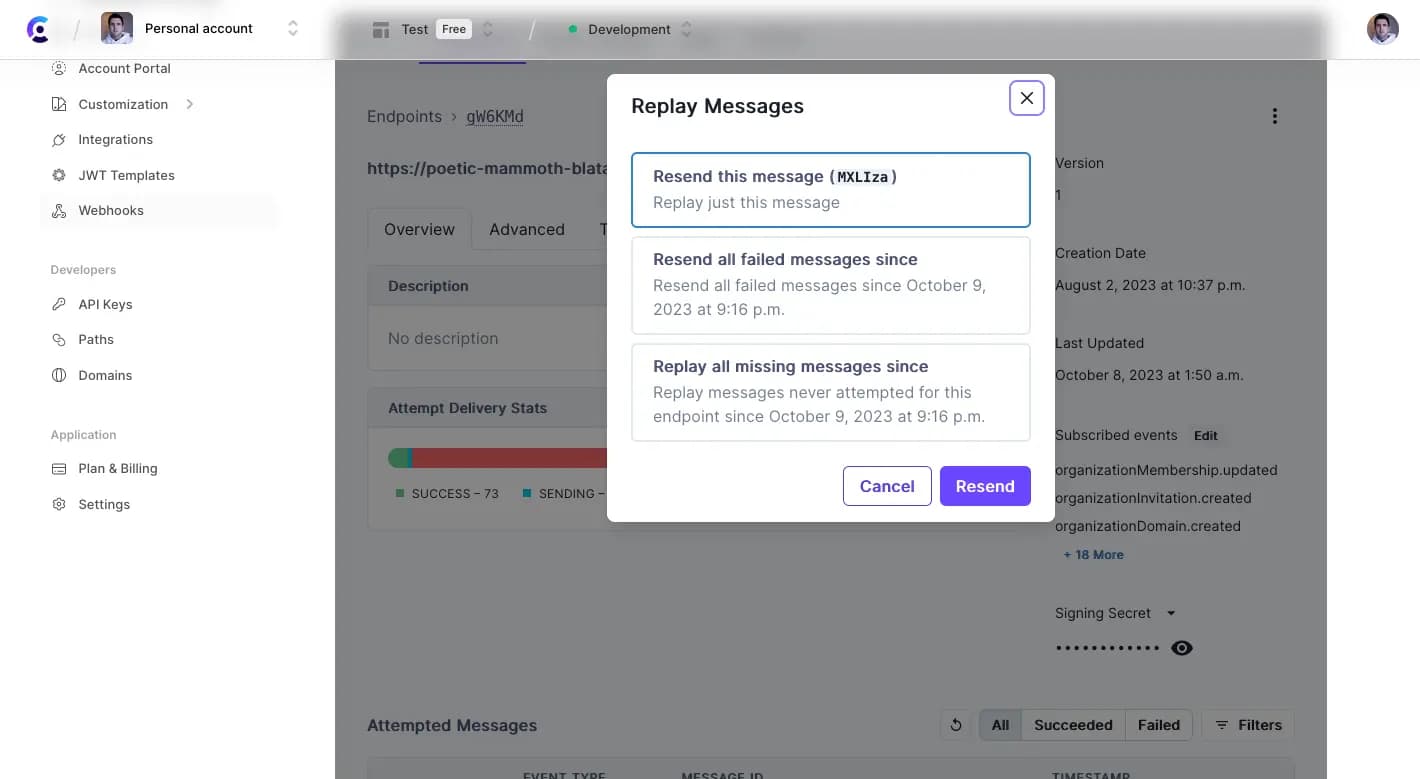Webhooks overview
Clerk webhooks allow you to receive event notifications from Clerk. Clerk will send a POST request to a URL you specify when certain events happen in your Clerk account.
Clerk uses Svix(opens in a new tab) to send our webhooks.
You can find the Webhook signing secret when you click on the endpoint you created on the Webhooks(opens in a new tab) page in the Clerk Dashboard.
Supported webhook events
Emails
email.created
Organization
organization.createdorganization.deletedorganization.updated
Organization Invitation
organizationInvitation.acceptedorganizationInvitation.createdorganizationInvitation.revoked
Organization Membership
organizationMembership.createdorganizationMembership.deletedorganizationMembership.updated
Organization Domains
organizationDomain.createdorganizationDomain.deletedorganizationDomain.updated
Session
session.createdsession.endedsession.removedsession.revoked
SMS
sms.created
User
user.createduser.deleteduser.updated
Payload structure
The payload of the message includes the type of the event in the type property.
The data property contains the actual payload sent by Clerk. The payload can be a different object depending on the event type. For example, for user.* events, the payload will always be the User object . For organization.* event type, the payload will always be an organization (except for when it is deleted).
Below is an example of a webhook payload for a user.created event:
{ "data": { "birthday": "", "created_at": 1654012591514, "email_addresses": [ { "email_address": "example@example.org", "id": "idn_29w83yL7CwVlJXylYLxcslromF1", "linked_to": [], "object": "email_address", "verification": { "status": "verified", "strategy": "ticket" } } ], "external_accounts": [], "external_id": "567772", "first_name": "Example", "gender": "", "id": "user_29w83sxmDNGwOuEthce5gg56FcC", "last_name": "Example", "locked": false, "last_sign_in_at": 1654012591514, "object": "user", "password_enabled": true, "phone_numbers": [], "primary_email_address_id": "idn_29w83yL7CwVlJXylYLxcslromF1", "primary_phone_number_id": null, "primary_web3_wallet_id": null, "private_metadata": {}, "profile_image_url": "https://www.gravatar.com/avatar?d=mp", "public_metadata": {}, "two_factor_enabled": false, "unsafe_metadata": {}, "updated_at": 1654012591835, "username": null, "web3_wallets": [] }, "object": "event", "type": "user.created" }
TypeScript support
Clerk provides the types as part of our SDK offering. Below is an example of type usage in a webhook handler:
import type { WebhookEvent } from "@clerk/nextjs/server" const handler = req => { const evt = req.body.evt as WebhookEvent; switch (evt.type) { case 'user.created': // UserJSON.first_name is a string const firstName = evt.data.first_name // UserJSON.last_name is a string const lastName = evt.data.last_name // UserJSON.email_addresses is an array of EmailAddressJSON const emails = evt.data.email_addresses; } }
Handling delivery issues
Retry
Svix will use a set schedule and retry any webhooks that fail. To see the up-to-date schedule, check out the Svix Retry Schedule(opens in a new tab).
If Svix is attempting and failing to send a webhook, and that endpoint is removed or disabled from the Webhooks(opens in a new tab) page of the Clerk Dashboard, then the attempts will also be disabled.
Replay
If a webhook message or multiple webhook messages fail to send, you have an option to reply the webhook messages. This protects against your service having downtime or against a misconfigured endpoint. To replay webhook messages, in the Clerk Dashboard, go to the Webhooks(opens in a new tab) page. Select the affected Endpoint. From the Attempted Messages section, locate a message you want to reply to, click the menu icon on the right side, and then select Replay.

Replay options
From the Replay Messages menu, you will have 3 options.
- Resend the specific message you selected.
- Resend all failed messages since the first failed message in that date range.
- Resend all missing messages since the first failed message in that date range.

Sync data to your database
You can find a guide on how to use webhooks to sync your data to your database here.
Protecting your webhooks from abuse
To ensure that the api route receiving the webhook can only be hit by your app, there are a few protections you can put in place:
-
Verify the request signature: Svix webhook requests are signed(opens in a new tab) and can be verified to ensure the request is not malicious. To learn more, check out Svix's guide on how to verify webhooks with the svix libraries(opens in a new tab) or how to verify webooks manually(opens in a new tab).
-
Only accept requests coming from Svix's webhook IPs(opens in a new tab): To further prevent attackers from flooding your servers or wasting your compute, you can ensure that your webhook-receiving api routes only accept requests coming from Svix's webhook IPs(opens in a new tab), rejecting all other requests.
Last updated on March 12, 2024